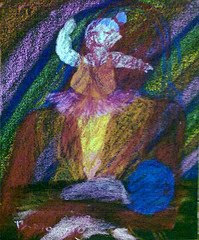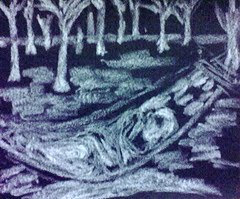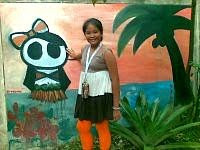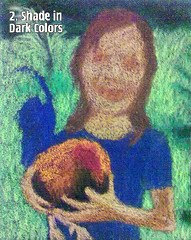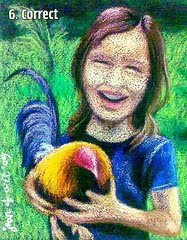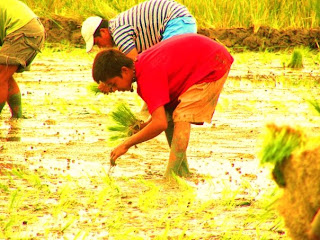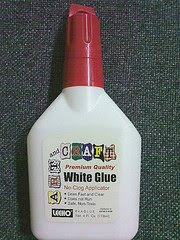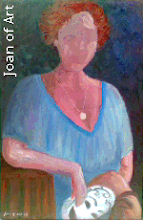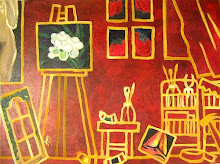

2009 Electric MassKara na. Face painting na naman. Ika-2nd year ko na ni dayon sa akon career as street face painter if ever...
Biyernes, October 16. Midnight sale sa Robinson's Place. Aga pa lang may gapamangkot na sa amon exhibit area kun may nagapang-face painting. Text ko ni Jane. Nge, may opisina pa ko ya. Pero si Bea, excited na. May plano na naman absenan ang iya ballet class (ay abaw, indi na inday, nagligad bilog nga bulan wala ka man aten-aten kay kun diin-diin man ang imo schedule, may exhibit sa Manila, may badminton, kundi namalayran ako isa ka bulan nga ballet nga wala man lang ginsudlan?).
Ako ya, gasala man kay may invitation sa opening sang art exhibit sa Capitana Dicang Gallery sa Talisay, may ara man kuno opening sa Moravia diri sa Bacolod. Ugaling, pagkagwa ko sa opisina, pwerte na ang traffic, ginreroute na gani ang mga jeep nga gaagi sa Lacson Street. Indi na ko ni ya kalab-ot sa Talisay and back in time for my cell group meeting sa Ikthus. Ako pa nga daan ang ma-lead sa praise and worship singing. Kapila man ko nag-absent sang adto ko sa Manila ga ulo-exhibit kag naabtan pa sang baha. Indi na ko mag-absent.
Pagkatapos sang amon cell group, larga na ko sa Robinson's. Nag-una na ya si Bea, kagina pa ang panawag niya sa akon sa cell phone pangayo tabang kay siya lang to isa gapaminta sang mga guya sang mga bata. Ang isa gusto dragon, ang isa gusto leon. Kundi sala si Bea, hehehe...
Pag-abot ko, damo man may nagpa-face painting. Galing, wow, indi na kami kaagwanta asta midnight, galing midnight sale abi sang Rob.
Sabado, October 17. Aga pa si Bea naglakat, mapractice naman siya ballet. Nagtext lang siya nga nag-commute na lang siya kag wala niya na lang ko ginpukaw. Pagbugtaw ko, nag-apas na lang ko mga alas onse na. Kagaina pa si Jane gatext nga may gahulat na mapa-face painting. Baw, aga pa!
Pag-abot ko may nagahulat na tuod nga customer. Si Chin ara naman, dala niya iya Baby Pabz, pero okay lang sa iya maobra craft earrings and bracelets. Ti, bira-bira dayon paminta eh. Pagkabuhi ni Bea sa iya ballet, derecho na siya sa Rob. Paminta na kami asta maghapon. Sang nagsambot na, bulig na si Chin. Damu-damo na gid ya mapaobra. Laban mga beautiful girls, mga bata, mga boys, kag mga agi! Nag-abot man dugay-dugay si Bogie kag mga lalaki nga artist nga upod niya. Si Carlos nagdala man iya pinta. Mansig-mansig pangita puwesto.
Isa sa mga customer ko ang mga managerial staff sang 18th Pala-Pala Seafood Restaurant. Pag-abot nila didto, nanamian sila sa face paint they decided nga ang mga waiters nila papintahan man nila ang mga guya para sadya. Gintawgan ako ni Euge, dali-dali man ako lumpat pakadto Pala-Pala kay gadulom na, lapit na dinnertime damu na na manugkaon sa ila sikat nga restaurant, dapat ready na mga guya sang ila waiters.
Pag-abot, plastar dayon sa ila opisina. Sa ila guwa gasugod na ang mga Bacolod Drumbeaters kag may fire dance pa. Wala gid ko kakita kay bira-bira kami ni Bea puli sa 19 ka guya, may naglagas pa nga 3 ka teenagers, mga apo na siguro sang tag-iya.
Pagkatapos, ginlakat na lang namon pakadto Lacson Street kay parallel lang man ang Aguinaldo. Ginbilin ko na lang akon salakyan didto nayon kay super linaktanay naman ni basta Electric MassKara.
Nakit-an namon sila ni Ian kag ni Edsy kag ang mga familiar SUGA artists nga nagasako na paminta sa atubang Gerry's Grill sa may Majica paper mache larger-than-life sculpture ni Charlie Co. Wow. Nagkalabuhi ang mga characters sa painting ni Charlie. As in, may bubbles-bubbles pa. Ka dreamlike yet nag-come alive. Bongga!
Plastar na naman. Hay bisan ano kadamu sang mga artist didto sambot gihapon. Ang sala ko lang kay wala ko ya kadala sang sample pictures sang mga designs nga naobra ko. Hulmanay lang ah. Kay usually gapangita gid designs nga pilian ang client. But I tell them naman, "No two paintings are alike." May lain gid na ya, depende sa stroke sang kamot nga gaupod sa sound sang concert scene nearby. Depende man sa personality sang ginapintahan kun carry niya.
Galing may ara gid ya nga undecided ko ano ang design so kinahanglan gid may guide. Ang iban naman nagdala pa picture sang ila apo kay amo gid na kuno ang pintahon sa iya guya! Ang iban gusto unique. Ang iban naman gusto ang pareho sadto sang babaye nga black-and-white attire kag ga-match man ang black-and-white tribal motif sa iya guya. Ang pinakabakal ko nga design ang butterfly with flowers-flowers kag dots-dots spray with glitters. Ang dason ang diwata style florals. Bestseller man ang tribal design, ang what I call the MassKara Festival Queen design. May ara man ya gapasugot lang sang bisan ano lang ang magwa sa mga kamot sang artist, which is more like it kay may freedom ang artist sa pagstroke sang iya design.
Standing room only ang instant street salon sang face painters. Tindog lang ang client, tindog man ang artist, bitbit iya paleta kag brush kag tubig nga sawsawan. Dapat balanse tanan bisan gapalangurog na ang batiis sa inoras nga tindog kay paghalin sang isa may mabulos naman. Kun indi pamilya-pamilya ang gapapinta, barkada-barkada. Basta sadya.
Ako ya may dala nga glitters for that extra special touch. Ti ang mga wala idlak, gakadto pa gid sa amon ni Bea para magpabutang glitters. Interesado man mag-face painting ang former student ko sa summer art workshop, si Elijah, nga maminta guya. Para ma-build iya confidence, siya anay ginpabutang ko sang glitters. Nakatatlo man siya ka ulo. Galing naglaag na sila ni Bea kag ni Rina kag ni Bianca pakadto 6th Street. Mga ala una na kag nagsurrender na ko sa kakapoy. Damo pa gyapon ang gapapinta. Matira ang matibay sa tinduganay ang mga nagkalabilin nga artist.
Domingo, October 18. Naburaw gid eh. Alas onse na sang ugto ako nakabugtaw. Si Bea alas dos sang hapon. Wala ko na lang ginpukaw ginpaayawan ko gid siya tulog kay luoy man bata (hay, amay namon, ano ang ginhimo mo?). Gatext na sila, damo na mapa-face painting aga pa. Text back ko ginapatulog ko pa si Bea. Kag masimba pa ko ya, pasalamat pa ko kay Lord kay gintagaan niya ako talent sa art kag bisan paano nakaracket kami sa puraot nga tiyempo. Mahatag gid ko kay Lord kay kun indi tungod sa iya, wala man ko amo ni nga grasya.
As usual, didto kami anay sa Rob. Nag-upod si Katherine halin sa simbahan. Adto na to si Chin, lipay na siya, may pambayad na siya sa kuryente niya. Bisan ara pa sila Norman kag Bogie, ay indi gihapon kaarapal. Indi na ko gani katext back halos kay Antonette kay hala pinta, picture, kag i-blog ko pa dason. Ang ini ya nga experience, ginhungod ko sulat sa Hilinglish kay daw bagay gid kag para lang ini sa mga nakaintiyende, meaning mga orig nga Bacolodnon kay total back story lang naman ini ti ano gid ya labot sang mga foreigners sa akon sulat haw...
Speaking of foreigners, ay abaw gapanong to sila ay, ang iban nagpasikat sang ila mga big bike sa atubang Starbucks, sukbit kada isa Pinay (ateng).
Halos indi na kami makakaon sang hala na lang kaobra paminta. Ang iban burger na lang para ang isa ka kamot gabitbit paleta kag ek-ek sa paminta, ang pihak nga kamot gabitbit palanyapunon. Ang iban ya makaon gid kan-on ti take out na lang sa Mang Inasal. Si Bea ko ya, mapungko gid ya. Didto gid sa isa sa mga nagahilera nga al fresco nga kalan-an. Pareho kagab-i, order kami barbecue, rice, sisig, baby back ribs, fruit shake. Naubos lang sa bongga namon nga panyapon upod kay Katherine kay siya man ang hali uyat karatola kag ganyat sang mga mapa-face paint. Partedahan ko man siya eh.
Sang nakapanyapn na kami mga lampas na alas onse, gusto ko na tani magpuli pero gusto pa gid nila maminta. Ti balik naman to kami sa amon puwesto. Ang iban nga artist nagpuli na kay ayos na sila kag kapoy na tiil sang tindoganay. Sila ni Ian may nabutong nga lamesa halin sa PNB. Si Leah, learning from last year's experience, nagdala gid gamay nga wooden table kag plastic nga pulungkuan. Ako ya nagdala plastic high chair. Imbes nga pulungkuan ang serbe niya, nahimo lamesa, tulungtungan sang mga pinta kag kagamitan namon ni Chin kag ni Norman.
Ay, kasadya ah. Nga kakapoy man. Sa sunod nga tuig, bisan mucho na ko, ma-face painting man ko gihapon. Ang racket pasadya-sadya lang na ya. Ang nanamian ko kay buhay na buhay ang turismo sang Bacolod tungod sa mga ideya sang mga artist. Halin sa pagconceptualize sang MassKara Festival itself pakadto sa bongga nga paper mache sculpture nga center of attraction subong nga tuig kag sa mga face painters nga nagproduce sang mga beautifully painted faces nga added feature sang Electric MassKara, maka-identify gid ang Bacolod sa slogan ni Tourism Secretary Ace Durano, "May Trabaho sa Turismo."
Amen!





 Shown in this picture are special guests Belgian Joke (YOW-kuh) van Kerckhove, Gabriela activist Grace, and the artist, Inday Espina-Varona.
Shown in this picture are special guests Belgian Joke (YOW-kuh) van Kerckhove, Gabriela activist Grace, and the artist, Inday Espina-Varona.







